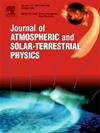Localized solar radiation zoning by combining spatially continuous estimates and Gaussian mixture models
IF 1.8
4区 地球科学
Q3 GEOCHEMISTRY & GEOPHYSICS
Journal of Atmospheric and Solar-Terrestrial Physics
Pub Date : 2025-01-13
DOI:10.1016/j.jastp.2025.106432
引用次数: 0
Abstract
With the increasing role of solar energy in the global decarbonization, precise geographical zoning of solar radiation becomes crucial. Traditional methods of solar radiation zoning struggle to accurately distinguish subtle spatial and temporal differences in solar radiation due to both sparse ground-based observations and the requirement for a predefined zone number, which limits their applicability for the demands of distributed photovoltaic system. This study introduces a novel method for localized solar radiation zoning, integrating spatially continuous solar radiation data with a Gaussian mixture model. High-precision spatiotemporal estimates of solar radiation are achieved by employing deep learning algorithms to analyze meteorological satellite imagery and digital elevation model data. The use of an infinite Gaussian mixture model along with variational inference allows for the adaptive determination of the number of solar radiation zones. The case study in Guangxi Province shows that incorporating Digital Elevation Model data reduces the root mean square error of global solar radiation estimates from 134.06 W/m2 to 87.68 W/m2 and accurately reveals temporal and spatial variability in both global and diffuse solar radiation. This approach not only prevents overfitting when the predefined upper bound surpasses the actual number of zones but also facilitates the development of zoning schemes that can range from fine-grained, capturing subtle variations, to coarse-grained, focusing on overall patterns. The outcomes lay a solid foundation for localized regional assessment and efficient utilization of solar energy resources.
结合空间连续估计和高斯混合模型的局部太阳辐射分区
随着太阳能在全球脱碳中的作用越来越大,太阳辐射的精确地理分区变得至关重要。传统的太阳辐射分区方法由于地面观测稀疏,且需要预先设定分区数,难以准确区分太阳辐射的细微时空差异,限制了其对分布式光伏系统需求的适用性。本文提出了一种将空间连续太阳辐射数据与高斯混合模型相结合的局部太阳辐射分区方法。利用深度学习算法分析气象卫星图像和数字高程模型数据,实现了对太阳辐射的高精度时空估计。利用无限高斯混合模型和变分推理,可以自适应地确定太阳辐射区的数目。结果表明,采用数字高程模式估算的全球太阳辐射均方根误差从134.06 W/m2降至87.68 W/m2,准确反映了全球和漫射太阳辐射的时空变化。这种方法不仅可以防止当预定义的上限超过实际区域数量时的过拟合,而且还可以促进分区方案的开发,这些分区方案可以从细粒度(捕捉细微的变化)到粗粒度(关注整体模式)不等。研究结果为太阳能资源的局部区域评价和高效利用奠定了坚实的基础。
本文章由计算机程序翻译,如有差异,请以英文原文为准。
求助全文
约1分钟内获得全文
求助全文
来源期刊

Journal of Atmospheric and Solar-Terrestrial Physics
地学-地球化学与地球物理
CiteScore
4.10
自引率
5.30%
发文量
95
审稿时长
6 months
期刊介绍:
The Journal of Atmospheric and Solar-Terrestrial Physics (JASTP) is an international journal concerned with the inter-disciplinary science of the Earth''s atmospheric and space environment, especially the highly varied and highly variable physical phenomena that occur in this natural laboratory and the processes that couple them.
The journal covers the physical processes operating in the troposphere, stratosphere, mesosphere, thermosphere, ionosphere, magnetosphere, the Sun, interplanetary medium, and heliosphere. Phenomena occurring in other "spheres", solar influences on climate, and supporting laboratory measurements are also considered. The journal deals especially with the coupling between the different regions.
Solar flares, coronal mass ejections, and other energetic events on the Sun create interesting and important perturbations in the near-Earth space environment. The physics of such "space weather" is central to the Journal of Atmospheric and Solar-Terrestrial Physics and the journal welcomes papers that lead in the direction of a predictive understanding of the coupled system. Regarding the upper atmosphere, the subjects of aeronomy, geomagnetism and geoelectricity, auroral phenomena, radio wave propagation, and plasma instabilities, are examples within the broad field of solar-terrestrial physics which emphasise the energy exchange between the solar wind, the magnetospheric and ionospheric plasmas, and the neutral gas. In the lower atmosphere, topics covered range from mesoscale to global scale dynamics, to atmospheric electricity, lightning and its effects, and to anthropogenic changes.
 求助内容:
求助内容: 应助结果提醒方式:
应助结果提醒方式:


